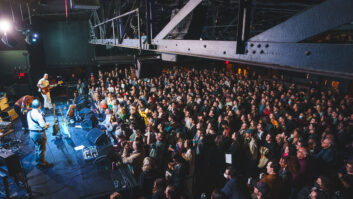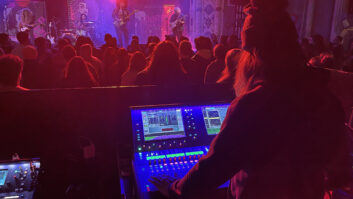NEW YORK—Since opening its doors in 1981, the Blue Note in New York City has become one of the premier jazz clubs in the world and a cultural institution in Greenwich Village playing host to some of the greatest musicians of all time such as Ray Charles, Sarah Vaughan, Oscar Peterson, Dizzy Gillespie, Lionel Hampton, Nina Simone, BB King, Tito Puente, Celia Cruz, Tony Bennett, Chris Botti, to name a few as well as modern hip-hop and R&B stars, including Lauryn Hill, Mos Def, Common and Lupe Fiasco. Recently the club received an upgraded sound system installed by Petrix.
“The Blue Note installation was a challenge,� states Amit Peleg, owner of Peltrix. “While the acoustical characteristics of the room are good, the audience sits around the stage which is positioned in the center of the room. There is only 15.5 feet from the front of the stage to the
wall across from it, 30 feet to the left and 46 feet to the right. The ceiling is low at 9′ 10″. Seating capacity is 200 with seats lined up right against the stage all the way to the walls.â€?
Peleg said that since the Blue Note is a jazz club and the music is mostly acoustic, 80% of the audience sits within 20 feet from the stage and can hear a lot of stage sound. The house system is used mainly to balance out the sound coming off the stage. There are three mixing zones designed to compensate for the position of instruments on stage. For example, audience sitting on house right usually hears mostly drums acoustically while stage right projects more piano. The bar area is yet a third mix as stage volume is much lower in that area. The house engineer has to walk around the room frequently to balance out the instruments and achieve an even mix around the room. If you sit on one side you are completely out of range of sound produced on the opposite side. Stereo imaging is not possible due to the stage location.
“We knew we needed DSP based amplifiers,� says Peleg. “A few months earlier, I tested a Yamaha TXn amplifier which impressed me with its quality of sound and control features. I worked with other DSP-based amps before, but some features in this amp gave us the extra control we were looking for. Although the TXn line is a relatively new model, I knew from experience that I can trust the Yamaha reliability, a paramount with every installation we do. While we had a full DSP control over each speaker, we still needed general DSP functionality that we employed with two dbx Driverack 4820s. After reviewing all options and deciding on the model of speakers to use, we sent SLS a Yamaha TX4n amplifier to install custom DSP settings for each individual speaker in the room. We then copied the DSP presets to the 11 other TX4n amplifiers as we have a dedicated amplifier for each speaker in order to control each individual speaker separately. This gave us the ability to not only control levels separately, but to actually customize other DSP settings for the individual speakers, compensating for bass traps, extra acoustical absorption, dynamic limiting, etc.�
The Blue Note initially bought one of the first five Yamaha M7CL digital consoles to arrive in the U.S. when the model was first released. “It worked very well, and in fact, lasted longer than any other console used by that club in its 30 years of existence,� Peleg states. “When time came to upgrade the club, it was a natural choice to go with a M7CL console again, but this time there were two extra incentives. The installation conincided with the release of StageMix, an iPad remote control application that comes in extra handy so now the house engineer can walk around the room and mix the individual zones described above right from their individual locations. There is no need to walk back and forth to the console, make changes and go back out to the zone to hear what you did, which is inefficient and disturbs the audience.�
Peleg noted that the second incentive to installing the Yamaha M7CL was the release of Version 3 software which allows the 3rd port to be used with an AuviTran Network ASIO Driver to facilitate DAW recording without any extra hardware. The Blue Note has a record label called Half Note Records which, over the years, has released countless live recordings from the Blue Note, some of which have won a GRAMMY®. Now, engineers can multi-track record shows right into Pro Tools for potential future use.
With the objective of low SPL combined with the speaker’s close proximity to the audience, Peltrix went with ribbon speakers in the Blue Note for the second time in 22 years. “They worked very well for the room, and when it was time to upgrade we went with ribbons again, but this time manufactured by SLS,â€? adds Peleg.
The entire sound system is digital. The only points of conversion are A-D at the stage box input and back, D-A at the output of the amplifiers. Everything in between is digital either via Ethersound or AES/EBU. The system is completely networked for both signal and control.
“Since the new sound system was installed, we have had artists ranging from straight-ahead jazz greats Michel Legrand and Toots Thielemans to R&B legend Al Jarreau and hip-hop star Mos Def, states Blue Note owner, Steven Bensusan. The new sound system has a versatility and range that can handle any genre being played on stage, and both the customers and the artists have noticed a difference.”
“A challenge equally problematic to the technical difficulties presented by the room was a logistical one,â€? Peleg says. “Other than a couple of days after September 11th, 2001, the Blue Note never closed its doors over its 30-year existence. They were not going to make an exception for us and close for the installation since a show takes place every night, 365 days a year. We had to complete the installation without affecting the normal operations of the venue. To overcome this challange, we installed the entire new sound system to be run simultaneously, side by side with the old system until it was time to make the final switch, all in one night, which is when we swapped out the speakers. But, it all worked according to plan, and we were ready on time for musician Bill Evans to “dust off” the new system.â€?
For more information on Peltrix, e-mail [email protected].
For more information on Yamaha products, visit www.yamahaca.com.
-END-
About Yamaha Commercial Audio Systems, Inc.:
Yamaha Commercial Audio Systems, Inc. (YCAS) provides a full line of integrated professional audio products offering complete systems solutions for the broadcast, sound reinforcement/installed sound, touring, commercial recording, and post production markets. The company remains the official U.S. and Canadian distributor for all NEXO speaker products. YCAS offers comprehensive in-house and field product training for its customers, a dedicated dealer network, and 24/7 technical support.





